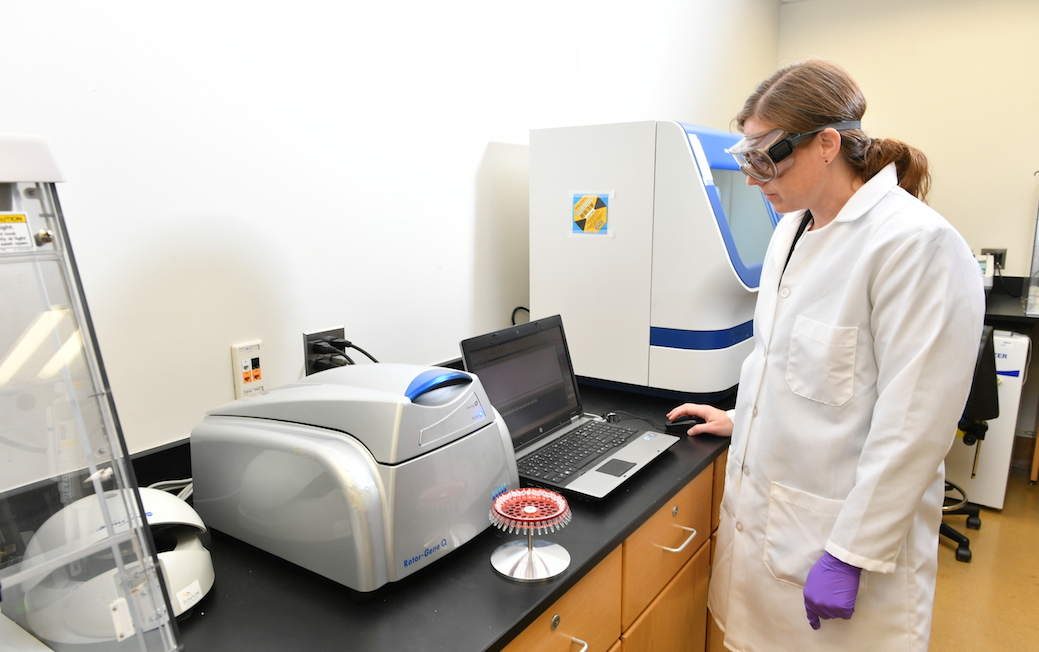Research spotlight on...Subrata Acharya and Kelly Elkins
The faculty team collaborated to design and implement an app to improve interpretation, data recording and security of colorimetric tests for tentative drug identification for crime scene investigations
By Megan Bradshaw on January 18, 2017

The proliferation of police procedural television shows has made crime scene investigations familiar to the public: Detectives swoop into a crime site and talk about fingerprints, DNA and blood spatter and then call for CSI.
But how do real-life crime scene investigators do their work efficiently and correctly to help law enforcement find the criminal? It turns out, there’s an app for that.
Towson University Jess & Mildred Fisher College of Science and Mathematics professors Subrata Acharya and Kelly Elkins received a grant from the Maryland Technology Development Corporation (TEDCO) Technology Validation Program to design and implement Crime Scene Investigation Presumptive Inquiry (CSIpi), an app to improve interpretation, data recording and security of colorimetric tests for tentative drug identification for crime scene investigations.

Illicit drug use is a serious problem in the United States. In 2012, the Federal Bureau of Investigation (FBI) seized US$1.125 billion worth of assets and drugs. The 2012 National Survey on Drug Use and Health by the U.S. Substance Abuse and Mental Health Services Administration reported an estimated 23.9 million Americans (9.2 percent of the population) aged 12 or older were current users of illicit drugs.
To determine the tentative identity and controlled status of the substances and to aid in petitioning for a search warrant to find illegal drug labs and drug distributors, colorimetric chemical detection tests or spot tests, also referred to as presumptive drug tests, are used at the crime scene. These tests are a well-established method of presumptive drug identification for crime scene use, but test results can be interpreted subjectively or impacted negatively by climate conditions.
“One of the strengths of a quantitative and electronic approach to evidence gathering, analysis and reporting is improving response time and recording accuracy in investigations in comparison to paper-based techniques,” said Acharya. “Records stored with appropriate security safeguards and controls prevent and limit the errors due to lost or misfiled paper reports. It is our goal to produce a tool that will help in reducing false positives and false negatives and improve the overall cost of CSI by improving the interpretation and reducing the recording time necessary to conduct an effective investigation. The software can search, and differentiate from, thousands of color data sets from this library in a matter of milliseconds.”
Several TU students have been involved in this project: MSFS graduate students Alex Weghorst and Alicia Quinn, forensic chemistry major undergraduate students Sun Yi Li, Thomas Boise, and Dallas Magee, TU undergraduate student India Eady, computer science graduate student Gabriel Susai, and computer science undergraduate students Saurabh Khatiwada and David Smith.
After designing the app for various platforms (iOS, Android and Raspberry-Pi), the team is conducting beta-tests with collaborating agencies, such as the Maryland State Police and
Baltimore City Police Department, as well as other national crime lab partners to further improves the efficiency of the software and features of the application.
The team has been selected and have participated in a two-week National Science Foundation (NSF) Regional DC Innovation Corps program and qualified to submit a proposal for the NSF National Innovation Corps program, tentatively for the Summer 2017 cohort.
This story is one of several related to President Kim Schatzel's priorities for Towson University: TU Matters to Maryland.